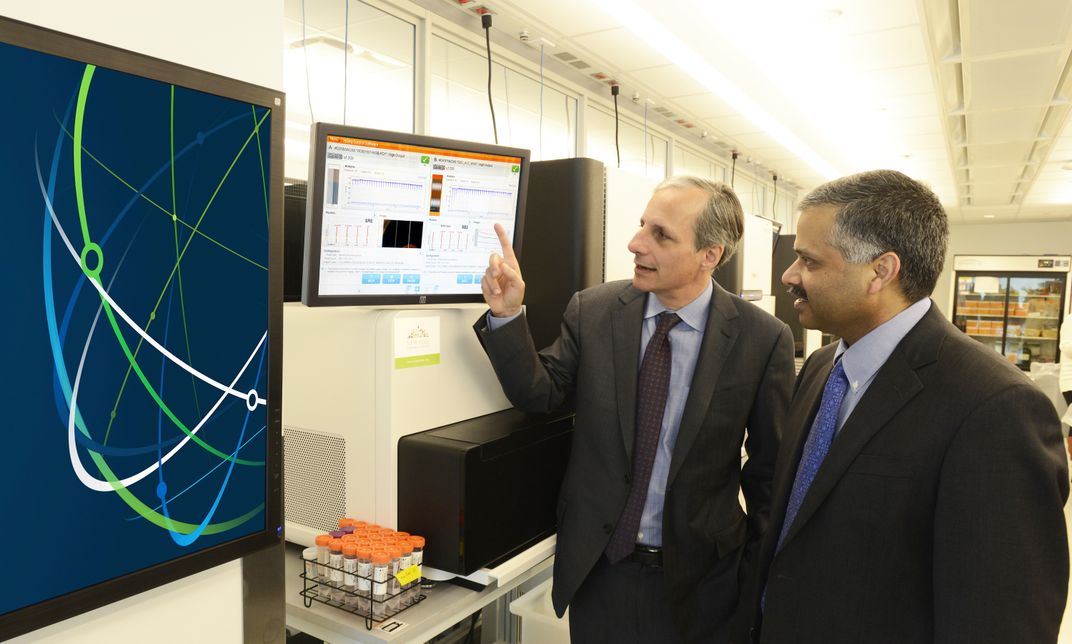IBM’s Watson Will Match Cancer Patients With Trials at Mayo Clinic
By pairing patients with trials in seconds, the supercomputer will help speed the pace of medical innovation
/https://tf-cmsv2-smithsonianmag-media.s3.amazonaws.com/filer/44/f4/44f40562-8ef0-43e8-904e-075ae08b96b7/watson-supercomputer.jpg)
In 2011, IBM’s Watson supercomputer bested 74-time "Jeopardy!" champion Ken Jennings. The machine, which had taken four years to develop, was a first of its kind: a computer that could understand complex questions, answer them and learn from its mistakes.
But for IBM, developing a cognitive computer—one that can process and contextualize natural language—wasn’t just about winning a game show. From the beginning, the project has been about solving information-intensive puzzles and making everything from banking and real estate to employment and medicine function more efficiently.
This week, IBM announced a partnership with the Mayo Clinic that will use Watson’s smarts to match Mayo patients with clinical trials for which they might be eligible, an initiative that will save time and, hopefully, lives.
At any given time, the Mayo Clinic has about 8,000 active clinical trials, and there are an additional 170,000 worldwide. Typically clinicians have to sift through medical records by hand to find matches for studies, a process that can take weeks and might not yield any viable options. “It’s a data- and time-intensive process and a very complicated question,” says Sean Hogan, vice president of IBM Healthcare. Watson, by comparison, can do the same work in a matter of seconds. “Cancer,” he explains, as an example, “is a race against time.”
Finding subjects for trials will also be a boon for research. As of now, only 5 percent of Mayo patients take part in clinical trials; the Watson clinical trial match program could double that number. Higher enrollment could allow researchers to complete their studies faster, improve the overall quality of their results and make refinements to their methods more quickly.
Initially, the program will focus on breast, colon and lung cancer, but it should eventually expand to include all types of cancer and other diseases. “Clinical trials for cancer are only 25 percent of our trials,” explains Nicholas LaRusso, a Mayo gastroenterologist and the project lead for the Watson collaboration. “Assuming [Watson] is helpful and beneficial, it could extend to all of our clinical trials.”
Mayo’s primary contribution will be Watson’s medical education. The clinic will provide the computer with the data it needs to build its knowledge base—lists of active trials and their criteria and current medical research. Clinicians will then query the system by entering patient records, diagnoses and histories to search for a match.
Because of Watson’s ability to build knowledge cumulatively, LaRusso says, it will get better and better at matching patients with trials over time. “In its relatively immature state, it may tell me that there are 26 trials that this patient is eligible for, but eventually it might be able to narrow it down to three or [even] say ‘this one is the best trial,’” he says.
The project is still in an early proof-of-concept phase, in which both teams are looking for feedback that will make Watson’s recommendations as reliable as possible. LaRusso explains that part of the process is logging how readily clinicians agree with and implement Watson’s suggestions.
Eventually, Watson should even be able to prompt doctors for information that would help it make the best clinical trial recommendation. For instance, Watson might ask the doctor for the results of a specific genomic test. “It’s not only identifying trials, but it’s expressing an opinion about what would be the best trials for a patient,” LaRusso explains.

LaRusso hopes to have Watson online for the clinical trial match program by the end of March 2015. Meanwhile, the team is already thinking about Watson’s next task at Mayo, what LaRusso calls the Clinical Efficiency and Effectiveness Project. For that effort, Watson will synthesize and analyze incoming patient records—histories, prior treatment, past diagnoses—into organized, cohesive histories. “This would be especially helpful for [patients] with diagnostic problems, people that have been seeing multiple doctors and have had multiple tests and prior opinions,” LaRusso says.
The Mayo Clinic isn’t the only institution to see Watson’s potential for crunching complicated medical problems, as several other initiatives are underway across the country. In March, the New York Genome Center announced that it would be training Watson to analyze patient genomes in order to create customized medicine for cancer patients. A partnership with the Cleveland Clinic has borne diagnostic tools that analyze electronic medical records and offer reasoned conclusions and recommendations. Not to mention, the computer has digested all of PubMed and MedLine, two mega research databases, and patient records from at least one major institution, New York City's Memorial Sloan Kettering.
Yet for LaRusso, any Watson-based medical advance isn’t just for the benefit of one institution. He expects the fruits of this collaboration to be utilized elsewhere in the medical community and to help the health care system deal with issues of rising costs and shrinking manpower.
“I think [this program] has the potential to substantially help in the transformation of health care,” he says.
/https://tf-cmsv2-smithsonianmag-media.s3.amazonaws.com/accounts/headshot/me.jpg)
/https://tf-cmsv2-smithsonianmag-media.s3.amazonaws.com/accounts/headshot/me.jpg)